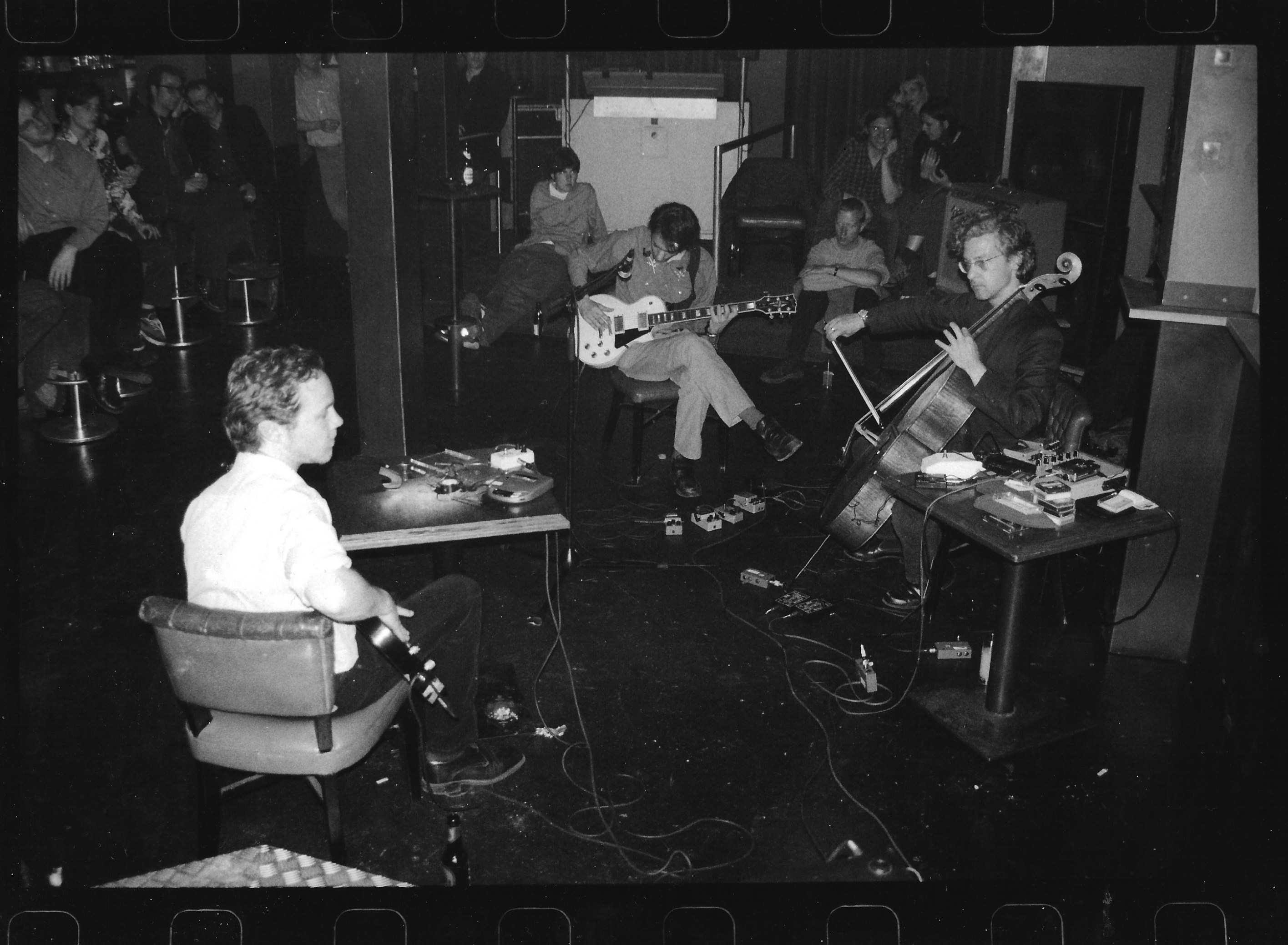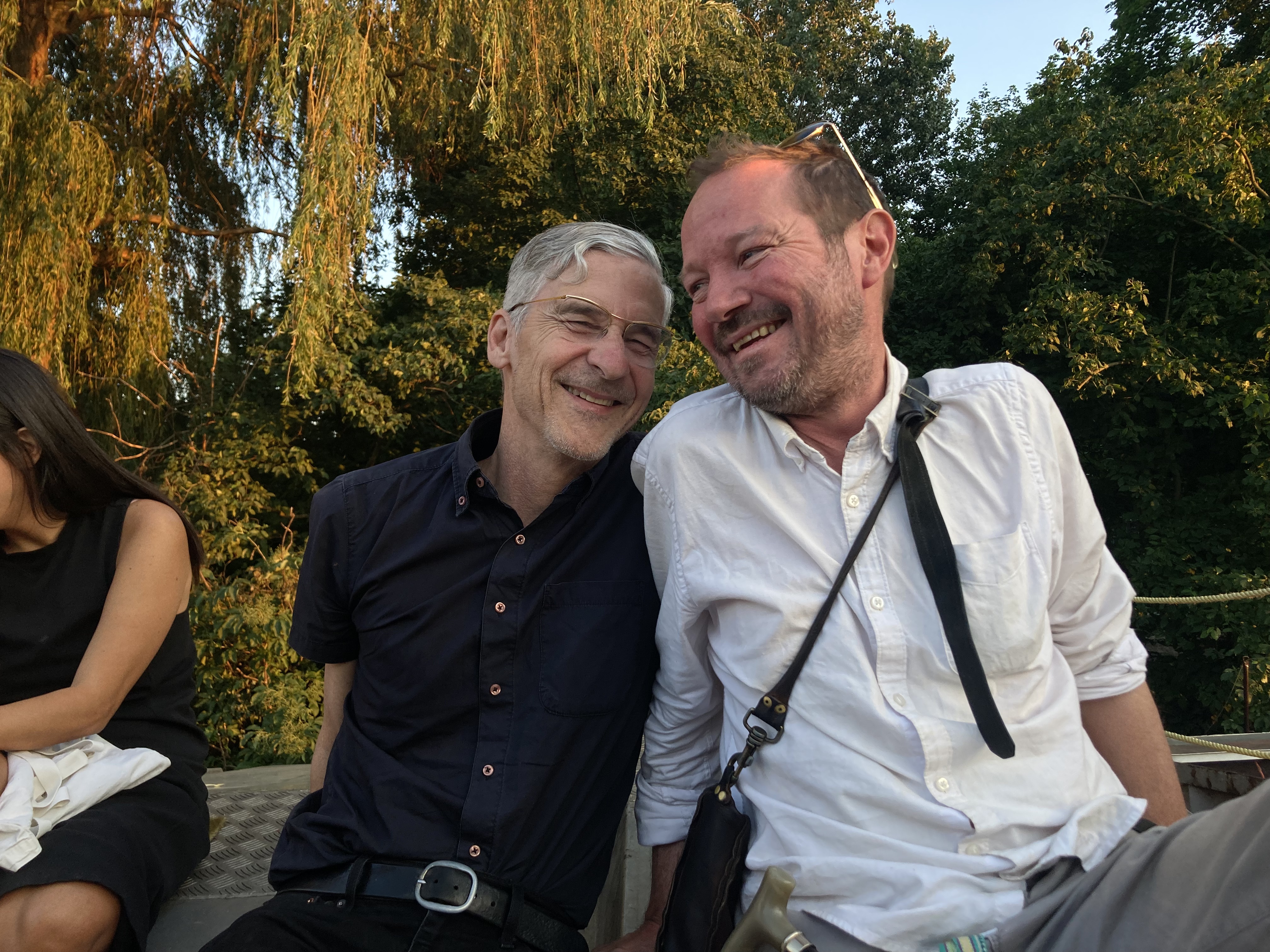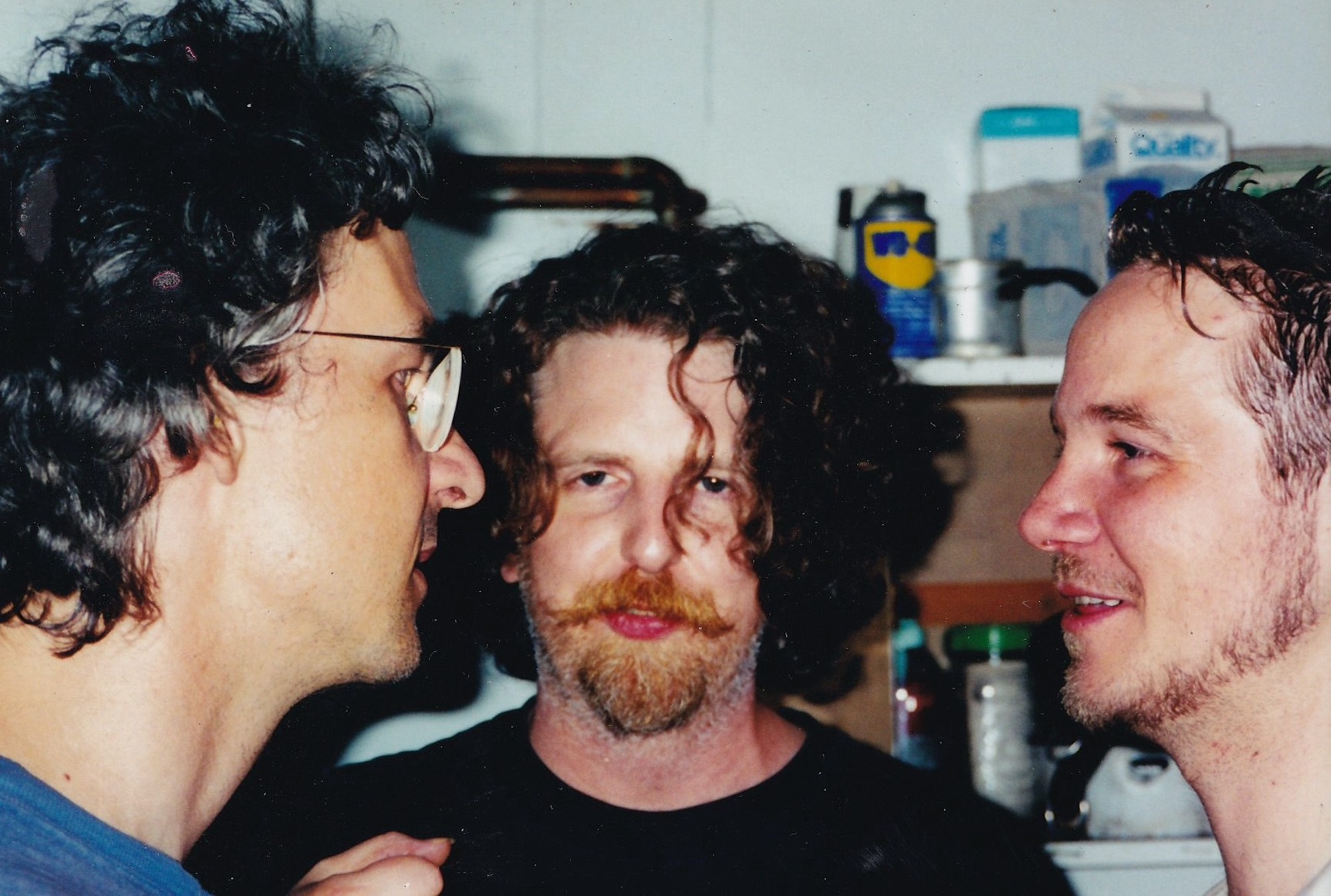
From left to right: Dean Roberts, Alan Licht, and Charles Curtis perform during their 1999 tour. Photo by Thomas Ankersmit.
Remembering Dean
by Charles Curtis
I saw Dean Roberts for the first time onstage at the Cooler, sometime in 1997 or 1998. A diminutive figure, he sat on the front edge of the stage, alone, cradling a guitar. In my memory he’s wearing a white button down shirt, open at the collar, and his pensive, faraway look made me think of a turn-of-the-century English poet. The music, as I recall, resonated like a heavy chain being dragged through an echoey chamber, not loud, not quiet, but rough and enveloping, seeming to hover above his small, motionless, utterly undemonstrative presence. It might have been a bill with Tower Recordings and Bardo Pond; it was that time. Tim Barnes, Alan Licht, Michael Schumacher, and Donald Miller formed the circle of friends; the Dream House, Michael’s Studio Five Beekman, Tonic, Jeff Perkins’s Fulton Street loft and Alan Lockwood’s East Village apartment were the locales.
The last time I saw him—and as it turned out, it was the last time—I had tagged along with Dafne and Simon to a show of improvised music on a barge in one of Berlin’s waterways. This was the summer of 2023; Dean and I had been in touch about the release of our trio recordings with Alan Licht, but we had not seen each other in many years. The audience was lounging, pre-concert, out in the sun on the upper deck; and I passed behind someone leaning back on his hands, in a white button-down shirt, open at the collar, and thought, I wonder if that’s Dean. Coming back to ask him—I really was not sure—he chanced to turn as I approached, and before I could open my mouth, his face went almost white, and he half whispered, “Charles ... what the fuck?!”
Now, almost exactly a year later, we learned of his death. We knew he was not well; but in all of my interactions with Dean, he exuded optimism and a kind of wistful cheerfulness, talking about the next move, the next idea, effortlessly bridging the many gaps in our communication with curiosity and heartfelt interest in me, my life, and the many people we mutually cared about. A gentle half-smile and a searching, intent way of looking at me make up the image I keep of Dean's face.
The irregularity of his appearances and disappearances made him a flickering presence. He sublet my apartment in Brooklyn until he was deported less than a year later. He would show up in Paris or in Italy seemingly out of nowhere. His music was talked about more than heard. But the music captures a kind of beauty that a more stable or grounded individual would never have access to. Parts of Not Fire (Erstwhile, 2020) give a glimpse of whatever it was that undid him. In some ways a disorderly record, it makes a mosaic of different recording sites and techniques, from iPhone recordings to proper studios, and calls on a roster of extraordinary friends playing for and with Dean. Pop song conventions are twisted, songs start and stop; a brittle and broken surface stretches over a depth of rich and seductive beauty. The listener is in both spaces: moved by the poignancy of the music, but contending with its willfully uneven exterior. Dean’s voice, totally free of affectation, breaks through the conglomeration like a troubling memory. The word “authenticity” seems too jaded for what I’m trying to put my finger on. It’s rare that an album captures its maker so directly.
Performing with him, I remember the sensation of knowing that he was playing, that he was making his guitar and amplifier do things, adding to the flow of sounds; but not being able to hear what sounds specifically he was making. On our trio record, too, I would be at a loss to identify what his parts are. He was there, but not there, at the same time. For some of us who knew him, this is how he will remain.
CC

Charles Curtis, left, and Dean Roberts in Berlin in 2023.
That Glistening Sound
by Alan Licht
That glistening sound, a spindly guitar tone with those attendant skittering, tingling harmonics, achieved by twirling a screwdriver on the back of the neck and headstock of a Fender Telecaster—that was Dean’s sound. The one I heard him get as one-third of Thela in 1996, when they first hit the US, and played a bill in Boston with two duos: me and Loren Connors, and Thurston Moore and Tom Surgal. I heard it again on Dean’s first solo album as White Winged Moth. I had also been applying a screwdriver to the guitar, albeit directly on the strings, over the pickups of a Gibson Les Paul laid across my lap, so I recognized a kinship right away. We both adapted the idea from Sonic Youth; Dean conflated their use of screwdrivers as slides and penchant for tapping the back of the guitar neck to bang out as many overtones as possible, while I went for a heavier sonic attack, more indebted to more indebted to heavy metal, Evan Parker’s circular breathing saxophone technique, and Angus MacLise’s cembalom playing. His approach was more intimate, a little reminiscent of Loren’s lonesome atmospherics. (When I saw his old record collection at his parents’ house in New Zealand, a few years later, he had my Live in NYC duo album with Loren (New World of Sound, 1996), as well as my Sink the Aging Process solo LP (Siltbreeze, 1994), which featured the screwdriver guitar).
Thela broke up a year or two later, but Dean returned to New York to take full advantage of the underground rock and avant music scenes, and we hung out quite a bit, often playing together. One session, where I was playing a chord organ, is credited on a limited-edition, lathe-cut White Winged Moth LP, Silo Blanket, but I swear I can’t hear myself on there. Another time, at Maxwell’s, Dean sang a couple of Bad Brains covers alongside my short-lived band with Tim Barnes and Sasha Frere-Jones; we announced him as “D.R.,” in a nod to H.R., the Bad Brains’ vocalist. I remember taking him to the Dream House one afternoon and to see Borbetomagus that same night. It was his first time seeing either; he was ecstatic. When I had a gig at the Khyber Pass in Philadelphia, I invited Dean to come along. We arranged a trip to Harry Bertoia’s Sonambient Barn the following day, where, amazingly, we got to play the sound sculptures.
Dean was always beaming during these fantastic shared experiences. That glistening sound—it wasn’t just a sound. It was a brightness you could see in his face, in his smile; it was an extension of who he was back then.
Charles Curtis was around then too, and he proposed we play as a trio across Europe. We would improvise with selected sine tones, deepen our friendships, and expand our own aesthetic boundaries. Charles had a booking agent who was amenable to the idea, and it all came together in the spring of 1999. Dean was already abroad, so he booked an additional improv set for the two of us at Rhiz, the hotspot for experimental music in Vienna, just before the trio dates commenced. He’d already made contacts there, including with Werner Dafeldecker and other Austrian improvisers, whom he would go on to work with extensively in the coming years. Midway through the tour, we were on the road when it started pouring rain, hard enough that we had to pull over. Charles had a cassette or a CD of the then-new Mark Hollis solo album, so he put it on and we listened to the whole thing, waiting for the storm to subside. I felt that those forty-five minutes marked a sea change in Dean’s music. Even in the car I could tell that he was very affected by the Hollis album’s starkness, its non-idiomatic song stylings; I hear its influence in everything he did after that. (Around the same time, he strongly recommended John Cale’s Music for a New Society to me; I think that record’s uneasy, dark-night-of-the-soul mood informs a lot of his song-based music too.) Dean was 24 at that point, younger than both Charles and myself; the trio was still an early touring experience for him, and in hindsight, a seminal one.
You can still find that glistening sound in the records he did next, mixed in with his own singing and a full band. He was in “post-rock” territory at that point, with some Oval-esque glitchiness thrown in, as was prevalent at the start of the millennium. I kept in touch with him in those years, although he was itinerant after leaving New York, and I wasn’t always sure of his whereabouts. I saw him in Auckland when I toured New Zealand in 2004 with Tetuzi Akiyama and Oren Ambarchi. He invited me to come visit Gibbs Farm, a sculpture park, on a private tour with him and his father, who had worked on it as a conservationist. (It’s home to, among other things, the world’s largest Richard Serra sculpture, an awe-inspiring sight—until you get close enough to see all the sheep manure accumulated along the bottom.) I returned the favor by getting him an invitation to dinner at Chris Knox’s house, where I was staying. They already knew each other, but it was a big deal to Dean. “You don’t know what this means,” he told me. “It’s like going to Springsteen’s house for dinner!” (That glistening sound, again.)
In 2012, Dean popped up in Melbourne, where I was playing a festival with Text of Light and Lee Ranaldo & the Dust. He was there working for a filmmaker named Vincent Ward, someone who I was familiar with because Kino Lorber, my former employer, had distributed one of his films. But Dean also seemed at loose ends; Lee, Tim Barnes, Ulrich Krieger, and I spent an afternoon with him, but when we had to leave for soundcheck, he was noticeably unsure of where the rest of the day was going to take him—he even had the slightest air of desperation.
Over the past ten years, we exchanged sporadic emails. Sometimes he would reply right away, sometimes not at all. More recently, I’d heard that his drinking was becoming an issue. But he proved to be a fairly reliable correspondent while reviewing the material from our 1999 tour, which Blank Forms ultimately released as May 99 (2023). In fact, his recall of the tour was far better than mine. He sent me and Charles a lengthy email with everything he could remember about that time. My favorite memory he shared was an anecdote I had completely forgotten:
There was somewhere, maybe Hamburg, where we were all 3 staying in an apartment and we got into a late-night discussion about how if one eats bananas or cheese before going to sleep the potassium digestion causes vivid dreams. I remember Charles made a challenge that we all eat a banana before going to sleep and that over breakfast the next day we'd recount our dreams. I don't recall mine but in Alan's dream he said that he visited his parents to discover Hanson were shooting a music video on the front lawn of the family home.
I hadn’t really heard any of Dean’s music for many years. After reading Charles’s remembrance, I listened to his last album, Not Fire (Erstwhile, 2020), … and that glistening sound was gone. I listened to a few other recordings I had missed, and it seems to have receded over time. I don’t expect anybody to make the same music over and over, or to keep doing the same extended guitar technique for thirty years—I myself rarely do the screwdriver thing anymore. But I have a gut feeling that this wasn’t simply a case of retiring an instrumental practice—or, even if it was, that this decision wasn’t entirely conscious. My sad suspicion is that the fading of that glistening sound in Dean’s recordings mirrored his own decline.
AL

At center, Donald Miller (1958–2024), a mutual friend of Charles, Alan, and Dean, who passed away earlier this week. At left, Charles Curtis; at right, Dean Roberts. Photo taken in 1999.